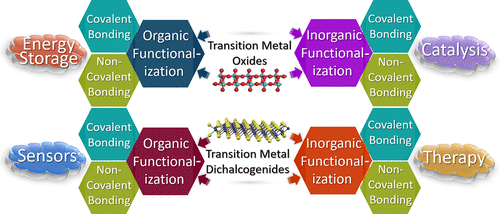当前位置:
X-MOL 学术
›
ACS Appl. Nano Mater.
›
论文详情
Our official English website, www.x-mol.net, welcomes your feedback! (Note: you will need to create a separate account there.)
Surface Functionalization of 2D Transition Metal Oxides and Dichalcogenides via Covalent and Non-covalent Bonding for Sustainable Energy and Biomedical Applications
ACS Applied Nano Materials ( IF 5.9 ) Pub Date : 2020-03-17 , DOI: 10.1021/acsanm.0c00120 Jalal Azadmanjiri 1 , Parshant Kumar 2 , Vijay K. Srivastava 2 , Zdenek Sofer 3
ACS Applied Nano Materials ( IF 5.9 ) Pub Date : 2020-03-17 , DOI: 10.1021/acsanm.0c00120 Jalal Azadmanjiri 1 , Parshant Kumar 2 , Vijay K. Srivastava 2 , Zdenek Sofer 3
Affiliation

|
The interest in two-dimensional (2D) nanomaterials has been increased rapidly after the discovery of graphene. The 2D graphene analogs (2DGAs) with ultrathin-layered feature exhibit a unique property which their bulk counterparts cannot possess. Among various 2D nanomaterials, the transition metal dichalcogenides (TMDs) and transition metal oxides (TMOs) have attracted considerable attention from scientific communities. The availability of various transition metals and their binding states in 2D TMDs and TMOs enable them to show a wide spectrum of properties such as metals to wide band gap semiconductors. Although properties of 2D TMDs and TMOs are excellent, further enhancement of their properties is still required for cutting-edge applications. The surface functionalization of 2DGAs is a potential route for enhancing their properties. The surfaces of 2D TMDs and TMOs could be functionalized with various types of organic or inorganic nanomaterials via covalent or non-covalent interactions. The functionalization may alter the Fermi level of 2D nanomaterials, also having this potential to add extra functionalities to the basis of the fabricated devices using them. In this review, we first introduce and specify the characteristics of 2D TMDs and TMOs as two important 2DGAs. Then, we discuss their limitations and how surface functionalization may enhance their performance. The covalent and non-covalent modes of surface functionalization with organic and inorganic nanomaterials on both 2D TMDs and TMOs are then considered. The current state and challenge of the functionalized 2D TMDs and TMOs are also discussed by their application point of view in energy storage and conversion, sensing, biomedical, catalytic combustion, and (opto)electronic devices.
中文翻译:

通过共价键和非共价键实现可持续能源和生物医学应用的2D过渡金属氧化物和二硫属元素化物的表面功能化
发现石墨烯后,对二维(2D)纳米材料的兴趣迅速增加。具有超薄层特征的2D石墨烯类似物(2DGA)具有独特的特性,而其他同类产品无法拥有。在各种2D纳米材料中,过渡金属二硫化碳(TMD)和过渡金属氧化物(TMO)引起了科学界的极大关注。二维TMD和TMO中各种过渡金属的可用性及其键合状态使它们能够显示广泛的性能,例如金属到宽带隙半导体。尽管2D TMD和TMO的性能非常好,但对于尖端应用程序,仍需要进一步提高其性能。2DGA的表面功能化是增强其性能的潜在途径。2D TMD和TMO的表面可以通过共价或非共价相互作用用各种类型的有机或无机纳米材料进行功能化。功能化可以改变2D纳米材料的费米能级,也具有向使用它们制造的设备的基础上增加额外功能的潜力。在这篇综述中,我们首先介绍并指定2D TMD和TMO的特征作为两个重要的2DGA。然后,我们讨论它们的局限性以及表面功能化如何增强其性能。然后考虑在二维TMD和TMO上使用有机和无机纳米材料进行表面官能化的共价和非共价模式。还通过它们在能量存储和转换中的应用观点来讨论功能化2D TMD和TMO的当前状态和挑战,
更新日期:2020-03-17
中文翻译:

通过共价键和非共价键实现可持续能源和生物医学应用的2D过渡金属氧化物和二硫属元素化物的表面功能化
发现石墨烯后,对二维(2D)纳米材料的兴趣迅速增加。具有超薄层特征的2D石墨烯类似物(2DGA)具有独特的特性,而其他同类产品无法拥有。在各种2D纳米材料中,过渡金属二硫化碳(TMD)和过渡金属氧化物(TMO)引起了科学界的极大关注。二维TMD和TMO中各种过渡金属的可用性及其键合状态使它们能够显示广泛的性能,例如金属到宽带隙半导体。尽管2D TMD和TMO的性能非常好,但对于尖端应用程序,仍需要进一步提高其性能。2DGA的表面功能化是增强其性能的潜在途径。2D TMD和TMO的表面可以通过共价或非共价相互作用用各种类型的有机或无机纳米材料进行功能化。功能化可以改变2D纳米材料的费米能级,也具有向使用它们制造的设备的基础上增加额外功能的潜力。在这篇综述中,我们首先介绍并指定2D TMD和TMO的特征作为两个重要的2DGA。然后,我们讨论它们的局限性以及表面功能化如何增强其性能。然后考虑在二维TMD和TMO上使用有机和无机纳米材料进行表面官能化的共价和非共价模式。还通过它们在能量存储和转换中的应用观点来讨论功能化2D TMD和TMO的当前状态和挑战,


























 京公网安备 11010802027423号
京公网安备 11010802027423号